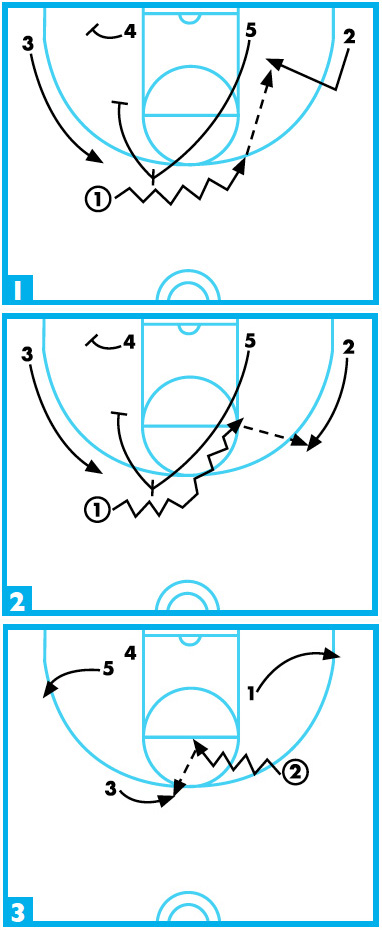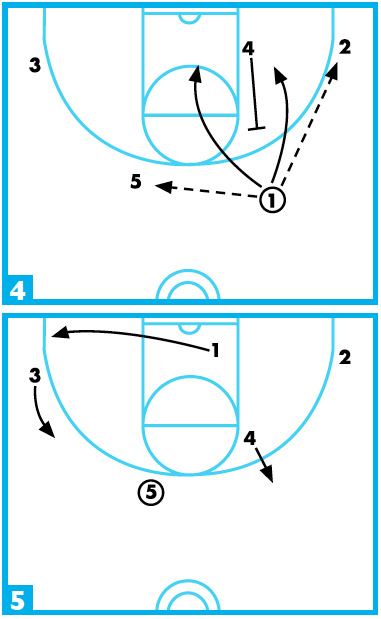Modifying the read & react offense to fit your team
The read and react offense is one of the more popular offensive philosophies in basketball programs. It teaches players to play with principle rather than learn set plays.

This offense is perfect for coaches at any level of basketball. Youth coaches who start using the read and react put their players at an advantage down the road because of the fundamentals and principles upon which this offense is based.
This system has players learn different “layers” of progressions until they’re mastered. That’s when players can move to the next layer. So, players who are exposed to the read and react early in their careers are at a distinct advantage, especially when their high schools coaches use this system.
As a high school coach who utilizes the read and react, I have been forced to tailor the system to my own needs, specifically:
- Having players who did not learn the early layers in their youth program,
- Trying to get enough out of the offense in the first year.
- Implementing enough of the offense without rushing players through layers before they’re mastered.
Layers 1-4 are critical
You cannot rush the learning of the first four layers. These early layers deal with circle movement and dribble penetration. Both must be installed immediately so these movements become habits among your players.
When you install the first four layers, be sure to utilize breakdown drills involving go-by moves, cross-over steps, passing and catching, shot fakes, finishing or any other fundamental essential to your program.
For example, when I taught circle movement (layer one), I introduced the baseline drive adjustment (layer two) right away along with the initial post reactions to dribble penetration (layer four). I also added a pass-and-screen-away layer after the pass-and-cut layer (layer three) to counter some of the sagging defenses we faced. To minimize confusion on the court, we designated whether we were in our “cuts” series or “screens” series.
Hard stuff early
The east-west dribble layers (layers five to seven) were difficult for our players to master. After learning circle movement, many of my players reacted to an east-west dribble in the same way they would to a north-south dribble (covered in first two layers). The east-west dribble layers are incredibly important but time consuming to perfect.
 To progress to the other layers, we had to spend a little less time on the east-west dribble layers. To do that, we incorporated some of those principles in our early-season offense and set calls. This allowed us to work on these more difficult layers when we had more time early in the season.
To progress to the other layers, we had to spend a little less time on the east-west dribble layers. To do that, we incorporated some of those principles in our early-season offense and set calls. This allowed us to work on these more difficult layers when we had more time early in the season.
Also, many coaches allow players to use east-west dribbles based on their skills, while the other offensive players can recognize the movement and the subsequent action they must take. The following are two examples of how to incorporate these movements and layers into your sets.
» ALSO SEE: Drills to teach the single-post offense
DIAGRAM 1: Speed dribble with a backcut. Try a speed dribble (layer five) with a backcut for a layup. This allows 1 to make an east-west dribble across the top of the set while 2 fakes popping out to the wing and cuts to the hoop. 3 fills the other wing, while 4 moves to the opposite-side short corner.
Another example is incorporating a circle reverse (layer seven) into the same alignment while changing the movement of the players.
DIAGRAM 2: Circle reverse with different movements (A). In this instance, 1 penetrates into the lane while 2 fills the ball-side wing for an open look.
DIAGRAM 3: Circle reverse with different movements (B). If 2 doesn’t have a shot, 2 dribbles to the center of the lane. 1 pops to the corner, 3 circles to the top, and 5 moves outside the arc. 2 passes to 3.
Set-to-set flow
Flowing naturally from set to set is the last layer, and it’s difficult to achieve in one season. You don’t want to incorporate different looks into your offense before getting to that layer. There are a couple ways to overcome this problem.
First, have calls from the sideline to help players start in different alignments. Have a “3” call be a three-out, two-in alignment, or have “5” be a five-open set.
 Second, incorporate an action into your secondary that allows players to go from one set to another. For example, you might want to start your action with a backscreen from the post after the first pass. So, you go from a four-out, one-in into five-open (Diagrams 4 and 5).
Second, incorporate an action into your secondary that allows players to go from one set to another. For example, you might want to start your action with a backscreen from the post after the first pass. So, you go from a four-out, one-in into five-open (Diagrams 4 and 5).
DIAGRAM 4: Backscreen from post (A). To go from a four-out, one-in set into a five-open, have 4 come high to set a backscreen for 1. 1 passes to 2 or 5, then cuts into the lane.
DIAGRAM 5: Backscreen from post (B). 1 passed to 5, so 2 remains in the corner. 4 pops out after the screen. 3 fills the wing area, and 1 moves through the lane to the corner. Now, you’re in a five-out set after starting four-out, one-in.
Layers to emphasize in read & react
Depending on the opposing defense, there are certain layers of the offense to emphasize (with circle movement critical against any defense, which is why it’s taught first). Here are some suggestions for layer emphasis against certain defenses.
Sagging man-to-man:
- Power dribbles (layer six).
- Safety valve in circle movement (part of layer one)
- Pin and skip (layer 14).
- Pass-and-screen away (layer added after we added pass-and-cut).
Pressure and all-out denial:
- Speed dribble (layer five).
- Pass and cut (layer three).
- Backscreens (layer eight).
- Multiple staggered screens (layer nine).
Read & react vs. zone offense
 Early in the season, coaches try to fit all of their offenses, defenses, press breakers, transitions and everything else into their practice plans. That’s why the read and react is so valuable. It can be used against any defense, including zones.
Early in the season, coaches try to fit all of their offenses, defenses, press breakers, transitions and everything else into their practice plans. That’s why the read and react is so valuable. It can be used against any defense, including zones.
The read and react features some adjustments against zones, like passing and making a seam cut rather than a simple pass and cut, while also adding short corner as a place to fill.
Against zones, we emphasize the circle movement with safety-valve option (layer one), pin-and-skip (layer 14) and pass-and-seam cut (layer three). We also begin running our zone offense with a three-out, two-in set. When doing this, have your post players look to screen in for the pin-and-skip, then step across to the middle. Also, have the strong-side post player fill the short corner when the ball is on the wing.
DIAGRAM 6: Post player filling short corner. Against a zone, have your post player fill the short corner. In this example, 1 passes to 2. 1 cuts into the lane, then fills the opposite wing. 3 fills to the top, and 5 moves to the short corner when the ball is on the wing.
When the ball is passed from the wing, look to pin on the side from where the ball came, then have the post step in (Diagram 7).
DIAGRAM 7: Pin & step in (A). 2 passes to 3 at the top. 5 pins the wing defender, then steps into the middle of the lane. 4 also steps into the lane to occupy the middle defender.
DIAGRAM 8: Pin & step in (B). After 4 steps in, 1 moves to the corner for a possible catch-and-shoot opportunity or to start the circle movement if 3 punches a gap with the dribble. 2 then fills to the top. 4 moves to the short corner, and 5 hits the weak-side block.
David Jooss is a former boys basketball coach at East Troy High School in Wisconsin.









